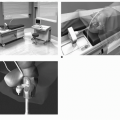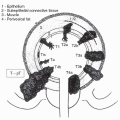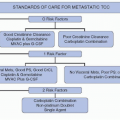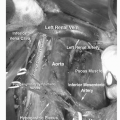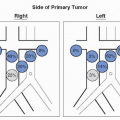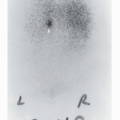Testicular Cancer: Clinical Signs and Symptoms
Timothy A. Masterson
Stephen D.W. Beck
Testicular cancer, although relatively rare, is the most common malignancy among men aged 15 to 35 years. Prior to the introduction of cisplatin-based chemotherapy in the mid-1970s, testicular cancer accounted for 11.4% of all cancer deaths in the 25- to 34-year age group (1). With platinum-based regimens, it is now expected that 95% of patients with early-stage testicular cancer, and up to 70% to 80% of patients with advanced disease, will survive. The American Cancer Society estimates that in the year 2009, about 8480 new cases of testicular cancer will be diagnosed and 350 men will die of the disease in the United States (2).
The diagnosis of testicular cancer is typically not difficult. Over 95% of solid testicular masses are neoplastic, and combined serum tumor markers alpha-fetoprotein (AFP) and human chorionic gonadotropin (HCG) are elevated in 90% of patients (3,4). For the vast majority of men, the diagnosis of testicular cancer can be included or excluded with scrotal examination and serum tumor markers. Nevertheless, occasionally, the diagnosis of testicular cancer can be problematic and must remain at least on the differential for young men presenting with an array of signs and symptoms.
SIGNS AND SYMPTOMS
Scrotum
The most common presentation of testicular cancer relates to the site of origin and typically presents as a nodule or a painless swelling in one gonad (Table 28.1). A painful testis is the next most common symptom, and in 10% this pain is acute on onset (5). Testicular pain at presentation is possibly secondary to hemorrhage or mass effect and has been linked to rapid tumor growth observed in nonseminomatous germ cell tumors (NSGCT). Seminomas have a slower growth rate and more often present with a painless mass. Sandeman reported testicular pain as the initial presenting symptom in 47% and 38% of nonseminoma and seminoma patients, respectively (6).
TABLE 28.1 SIGNS AND SYMPTOMS OF PATIENTS PRESENTING WITH TESTICULAR CANCER (%) | ||||||||||||||||||||||||||||||||||||||||||||||||||||||||
|---|---|---|---|---|---|---|---|---|---|---|---|---|---|---|---|---|---|---|---|---|---|---|---|---|---|---|---|---|---|---|---|---|---|---|---|---|---|---|---|---|---|---|---|---|---|---|---|---|---|---|---|---|---|---|---|---|
| ||||||||||||||||||||||||||||||||||||||||||||||||||||||||
Trauma is observed in 10% of patients with testicular cancer (7,8,9,10). Trauma was once regarded as a risk factor, because the enlarged gonad secondary to malignancy is more prone to injury, and injury itself leads to recognition of the preexisting tumor (7). Other red herrings, including epididymo-orchitis, torsion, hydrocele, and hernias, all lead to misdiagnosis and delay in diagnosis. Although nearly two thirds of patients with testicular cancer have an abnormal semen analysis at presentation, infertility as an initial complaint is uncommon (<5%) (11,12,13).
Retroperitoneum
The primary landing zone for metastatic spread in testicular cancer is the retroperitoneum, which is the most common location of lymphatic disease. Though frequently involved with tumor, retroperitoneal disease is typically asymptomatic and most commonly identified at the time of metastatic workup, after the diagnosis of testicular cancer is reached. However, approximately 10% to 20% of patients do present with symptoms of distant metastases (7,9,10), with the retroperitoneum
representing the most common site of disease. At Indiana University, back pain was the presenting symptom in over 10% of patients, and half of such patients presented with retroperitoneal malignancy >10 cm. Other signs and symptoms of abdominal malignancy include gastrointestinal disturbance or hemorrhage, weight loss, palpable mass, and flank pain from ureteral obstruction.
representing the most common site of disease. At Indiana University, back pain was the presenting symptom in over 10% of patients, and half of such patients presented with retroperitoneal malignancy >10 cm. Other signs and symptoms of abdominal malignancy include gastrointestinal disturbance or hemorrhage, weight loss, palpable mass, and flank pain from ureteral obstruction.
Supradiaphragmatic Disease
Metastatic disease above the diaphragm can present on examination with pulmonary symptoms including shortness of breath or hemoptysis, or radiographically with pleural effusions. Enlargement or tenderness of the breast was noted in 33 of 1044 patients at Indiana University. Daniels and Layer reported on 175 men who presented to a breast clinic with gynecomastia, of whom 4 had testicular cancer (14). Secretion of beta-HCG by germ cell tumors stimulates estrogen secretion from Leydig cells with resultant gynecomastia. Leydig cell tumors have a higher incidence of gynecomastia (10%-20%) than do other testicular tumors, secondary to direct production and secretion of estrogens from the tumor. Other locations of metastatic spread include the neck (about 10%), other supraclavicular locations and, less commonly, the cerebrum. In a report of the International Germ Cell Cancer Collaborative Group (IGCCCG), initial brain metastases were observed in only 70 of 5862 patients with metastatic germ cell cancer (1.2%) (15).
Biologic Significance
Clinical signs and symptoms of metastases at initial diagnosis may reflect biologic aggressiveness and predict outcome. The size of the primary tumor, although an integral part in most oncologic staging symptoms, is not included in the TNM staging of testicular tumors (16). However, Warde et al. reported the effect of tumor size on relapse in patients with clinical stage 1 seminoma (17). The 5-year relapse-free rate for 317 patients with primary tumor size of 4 cm or smaller and for 281 patients with tumor size larger than 4 cm was 86.6% and 75.9%, respectively (p =0.003). At Indiana University, reviewing 779 patients with clinical stage 1 NSGCT, we were unable to demonstrate this same predictive value of primary tumor size for the nonseminoma group (18).
Initial risk stratification models incorporated clinical signs and symptoms as predictive of outcome; they included palpable abdominal disease [Indiana University and National Cancer Institute (NCI) models], pleural effusion, and obstructive uropathy (NCI model). Additional risk assessment for Indiana University, NCI, and the European Organization for the Research and Treatment of Cancer (EORTC) included liver, osseous, and CNS metastases. To standardize risk stratification, the IGCCCG evaluated data on 5202 patients with NSGCT and 660 patients with pure seminoma (15). For NSGCT, the following independent adverse factors were identified: mediastinal primary, degree of serum tumor marker elevation, and presence of nonpulmonary visceral metastases. For seminoma, the predominant adverse feature was the presence of nonpulmonary visceral metastases. No signs or symptoms were evaluated for prognostic significance in this multinational collaboration. Quantifying such factors would be difficult and open to wide interpretational variability. Despite these limitations, clinical symptoms and signs remain an important tool for the astute clinician for diagnosis, evaluating response to therapy, and identifying relapse.
Delay in Diagnosis
The identification of a given cancer in a timely fashion facilitates both diagnosis and treatment at an earlier and potentially more curable stage. The time beginning from the perceived onset of first symptoms until the implementation of treatment is considered the diagnostic interval. Deductive reasoning would hypothesize that a shorter diagnostic interval would translate into improved oncologic outcomes and reduced morbidity for patients undergoing treatment.
Despite the external location of the male gonad, allowing accessibility for both self-exam and physician-performed exam, delay of diagnosis for testicular cancer continues to occur. Delay of diagnosis is not uncommon, with a reported mean delay time of approximately 26 weeks (19). While a few investigators more recently have shown a reduction in diagnostic delay attributable to increased efforts at education and recognition (20,21,22), these rates have remained relatively steady over time (19).
Several factors have been attributable to these delays in diagnosis, including both patient- and physician-related causes. Patient-mediated delays include the fear of cancer and the consequences of treatment; embarrassment and concerns over castration and emasculation; and ignorance regarding the recognition of the signs or symptoms of cancer (23,24,25,26). While Dieckmann et al. found educational level to be associated with earlier detection (27), others have shown educational background and socioeconomic status had no impact on diagnostic delay (28). Testicular cancer most commonly occurs during the reproductive years when sexuality and self-image remain important. Because of this, various coping mechanisms such as denial and misattribution come into play, leading patients to delay seeking medical attention. In fact, it is often the female partner who persuades young patients to pursue evaluation (20,23,29).
Stay updated, free articles. Join our Telegram channel

Full access? Get Clinical Tree


